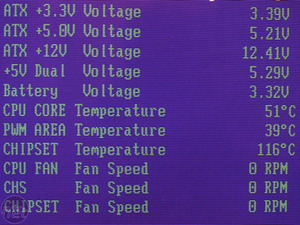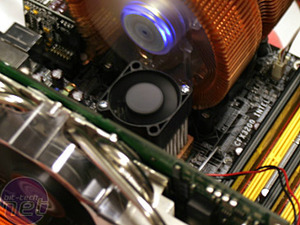Rounding things up:
This is a hard one to weigh up. The hardware and the board layout are generally very good. Sure, there are a few niggles but once you get the hardware in everything is pretty sweet. The three PCI expansion slots and six USB 2.0 ports on the rear I/O are a real bonus, and all the components are easy to plug into near the edges of the board.It's fair to say that the SB600 southbridge is still behind the cutting edge when it comes to feature set, but it works well. The extra Promise controller adds more SATA ports and also RAID 5 to bring it up to scratch with competing products, while the Realtek ALC885 audio is a bonus for those wanting to perhaps invest in a HD-DVD/Blu-Ray player for the PC, as it includes support for content protection.
It seems strange to see a DFI motherboard with a passively cooled northbridge, especially considering that better cooling is required in order to keep the chipset heatsink from emulating the surface of the sun at the super overclocks the board is capable of. I mean, would you buy a DFI motherboard with any other intent than torturing the equipment attached to it? DFI hasn't made this easier by making it clips instead of holes but it is do-able.
Using an old Swiftech MCX159-P northbridge cooler we were able to drop the temperature of the northbridge massively, increasing not only the life of the product but its stability when using high voltages. It's like the provided passive cooler is just there as a formality or courtesy, akin to the little chocolates you get with a coffee. However, if you just fancy going ghetto and whacking a big fan over it (held on with some zip ties or duct tape or similar), it should work quite well.


At >2V, even just sitting for hours idling causes this sort of temperature in an open air environment. It's still stable, just don't touch it!
Without a doubt the BIOS needs an education in itself. Don't assume you know anything much: the internet is your friend and I can wholeheartedly vouch for needing the guides and discussions provided here, and here. Take a week off work / university / school and get to know it intimately, because a little love given will give a lot of love back.
The question is though, where do you draw the line? Where does it become so inconvenient to have that many options that you need to spend hours upon hours learning how to use it? After you've mulled through the guides online, you still have to spend a few weeks getting to know your own hardware. In comparison there are numerous boards I've just gone into the BIOS and within a few minutes, I've been able to suss out how to run 3-3-3-9-1T and get very competitive performance.
I mean, I'm an enthusiast and I get paid to know what I'm doing when it comes to fiddling and tweaking a motherboard, but for two weeks I've been using this DFI board and I constantly find myself questioning my logic, where I change something, or a few things, or wonder if it's a different combination, or maybe it's the memory timings not the voltages... or what about the drive strengths? GTLRef? What was that value again? ARGH!
Does this / that / whatever actually make a difference? What should I be looking for? After all, a lock-up is a lock-up and I don't have an electrical engineering degree or an industrial debugging kit. You find yourself in and out of the BIOS like a ninja jack-rabbit on speed after he's cracked the matrix. You even get finger muscle memory because you come orientated with fiddling it all.
I do not doubt there will be some people who will love the BIOS DFI has given us here and will have the time to invest in getting their equipment stable at some super clock. Kudos to the BIOS engineers at DFI since they've seriously worked themselves into the ground creating a BIOS that the most extreme enthusiasts will have a wet dream over. But at the end of the day, other boards out there have been reporting overclocks of similar or in excess of what the RD600 is capable of. That’s not DFI's fault, but I fear the company may have invested the time in the wrong chipset when the engineers could have been looking in the direction of Intel's P965 chipset.
As wonderful as asynchronous clocks for memory and CPU buses are, you have to balance off the cost of everything to the potential performance gain. Since overclocking the memory bus alone offers not even an increase in theoretical maximum bandwidth at a 33% clock increase, the way to go is obviously to get the lowest timings possible at the highest clock, not just to go for the most you can because it becomes counteractive.
Increasing the CPU FSB independently also provides more used bandwidth, rather than just having oodles to spare by running huge memory clocks. This allows you to opt for some relatively cheap RAM, saving money, but still allow you to get a maximum CPU overclock. However, the question is: is it worth investing in a £180 LANParty board, cheaper PC6400~8000 DDR2 memory, or, is it better to buy a cheaper P965 board with equal overclocking capabilities, and better memory. DFI certainly hasn't made a definitive choice here, but the company has definitely made a viable alternative.
As I said before, no one is going to run the ICFX3200 T2R/G at stock speeds, so assessing stock performance is just a formality. Despite the fact the board is limited to 511MHz CPU bus (higher clocks are attainable using the windows based AMD system tool, proving your board is capable of doing those speeds), very rarely do people get over 500MHz 24/7 stable.
We did manage a very healthy 450MHz stable that would run through a full weekend of stress testing (using dual instances of Prime 95, IOMeter and Far Cry looping in the foreground) without so much as a blink. That gives you a healthy 2.7GHz using a 6x multiplier and that should be more than achievable on a £110 Core 2 Duo E6300. At this speed though, with the memory kept at 800MHz (PC6400) at 3-3-3-9-1T, you're always increasing the memory speed because of CPU bus throughput.
It comes down to the fact that both the CPU and Memory buses are completely independent; where the data has to jump off of one and wait until it can jump onto the other, rather than being tied together which is more efficient. RD600 has some latency issues which give it a large deficit in theoretical memory bandwidth, which has evidently permeated through our real world testing. It's not like the performance is at all poor though - it's also impeccably stable with a heavy overclock, providing you've got a degree in ICFX3200 T2R/G BIOS tweaking.
Final Thoughts:
DFI's LANParty UT ICFX3200 T2R/G is mostly a motherboard for enthusiasts that want to get serious about overclocking. It's for those of you that took stuff apart as a child, then played with those bits for longer than they had when the toy / remote / Dad's new phone was in one piece.For around £180 including VAT, the ICFX3200 T2R/G requires some serious investment, especially given that the heavily overclockable P965 boards top out at around the £140 mark and the promising nForce 650i boards are even cheaper. However, it's still cheaper than most of the problem-free nForce 680i SLI mobos that are £200+.
In that respect, the board falls into a bit of niche, where it's still an expensive motherboard (even more so considering it's the UT version that comes with a meagre bundle), but it's still not as serious of an investment as some boards on the market. So yeah, it's just like a Ferrari.





MSI MPG Velox 100R Chassis Review
October 14 2021 | 15:04









Want to comment? Please log in.